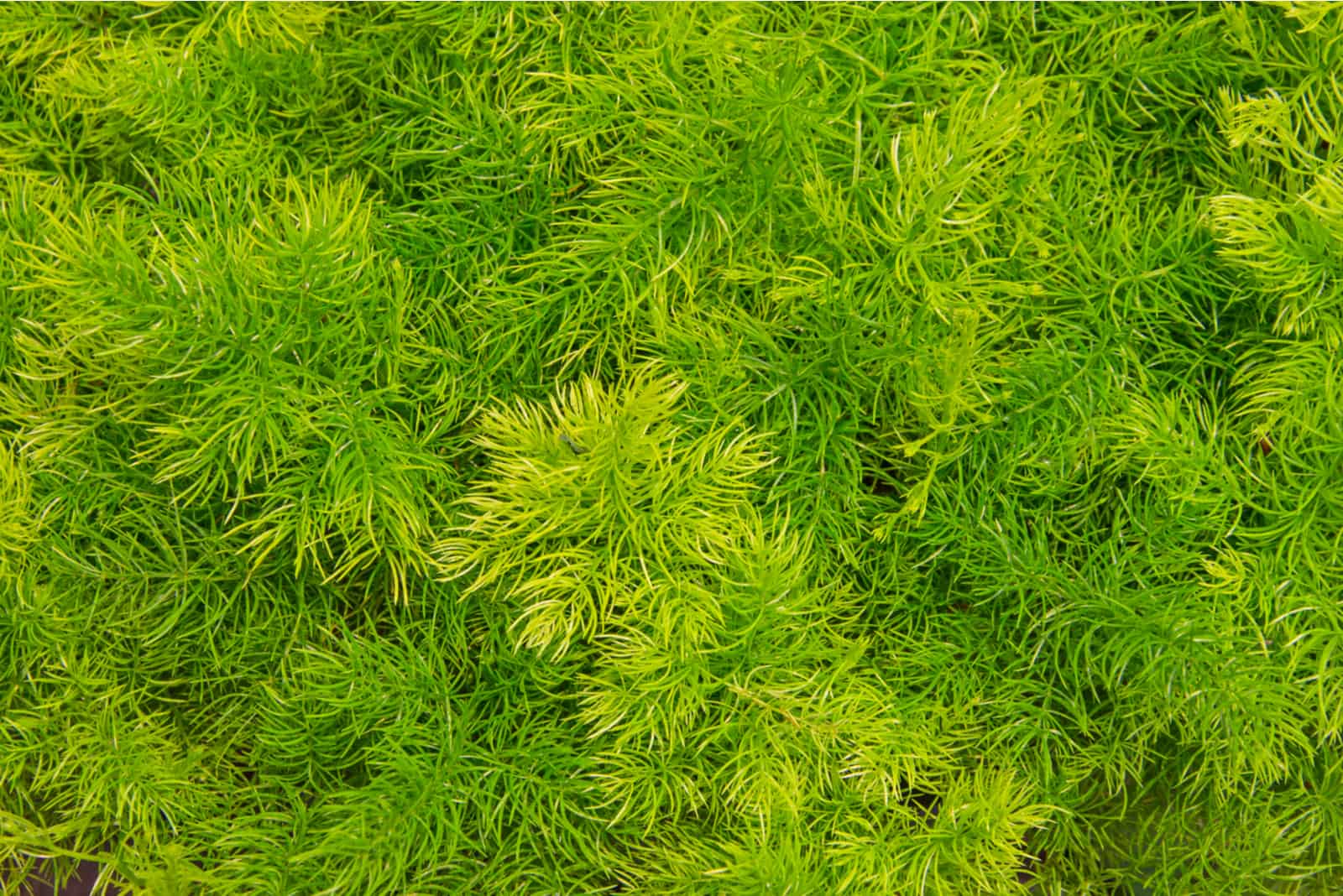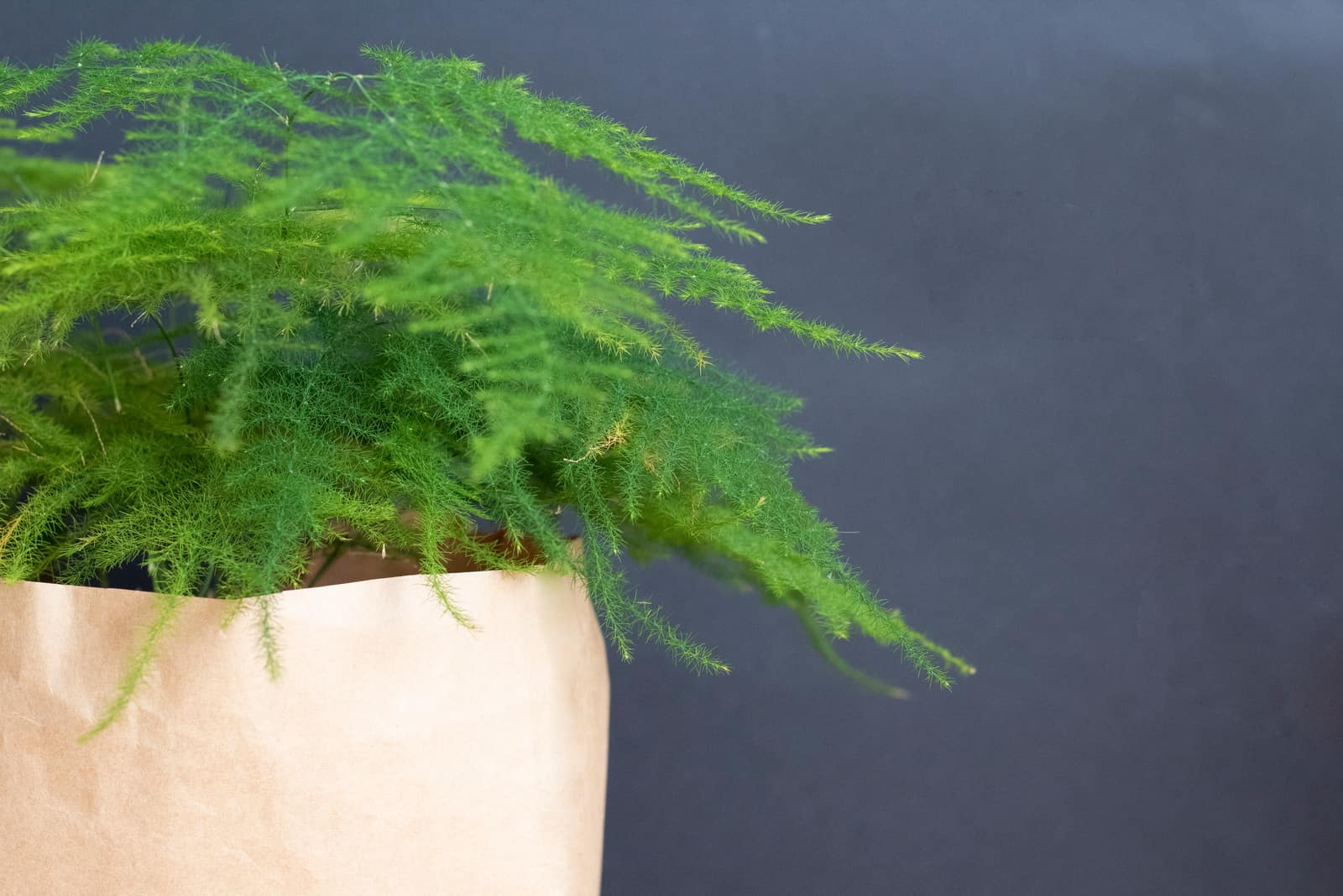If you want to add a new houseplant to your precious plant collection, look no further than the Asparagus Fern! Its beautiful green and lace-like foliage will look exquisite hanging from a basket in your room.
After a while, you may start noticing that some of the leaves turn yellow.
Don’t panic, you can still save your beloved plant!
Leaves changing color is usually an indicator that something is not right with your plant, whether it’s watering, fertilizing, or some other issue.
If you want to know what leads to an Asparagus Fern turning yellow, read on to discover everything you need to know and more!
Reasons For Asparagus Fern Turning Yellow
There might be a few reasons your delicate houseplant is turning yellow. It’s usually inadequate watering, low humidity, using the wrong fertilizers, and lighting.
If you own an Asparagus setaceus, Asparagus plumosus, or Boston Fern, and they also have yellowing leaves, you should check out these reasons as well because they apply to all Asparagus species.
1. Inadequate Watering
It can be tricky to figure out the watering requirements of such exotic plants, which can lead to you accidentally either overwatering or underwatering the plant.
These two watering issues can cause different problems and affect the overall health of your plant, so it’s important to learn how to differentiate and fix these two issues.
Underwatering
Even though Asparagus Fern are known for having tuberous roots that make the plant drought-resistant, being deprived of water for too long can lead to certain complications.
Yellow, brown, and crispy leaves are usually indicators of underwatering, however you can simply check if the soil is dry and you will be able to identify the real problem.
The water is the main factor here, although other factors such as humidity and high temperature can affect the water requirements. The same way you need to drink much more water during summer and in hot conditions, your plant will also need more water in certain situations.
How to fix:
Bear in mind that Asparagus Fern leaves won’t recover after turning yellow or becoming crispy, so you should prune these damaged leaves and your plant will grow new ones!
To fix the underwatering issue, you must adjust the watering schedule according to the plant’s requirements. The best thing would be to check if the soil has dried before watering it again: if it’s still damp, then water it after a couple of days.
If the soil is really dry and the leaves have started changing, then water it every other day for a week.
After the plant has recovered, switch back to watering once a week, but always check if the soil has dried before watering!
Overwatering
Opposite to underwatering, which is caused by a lack of water, is overwatering, which is when your plant gets more than enough water.
One of the main causes of yellowing leaves is overwatering, as Asparagus Ferns are known for being a bit thirstier than the majority of houseplants.
Constant watering causes the soil to become soggy, which can lead to root rot and damage the overall health of your plant. The roots are the most important part of the plant as they absorb the necessary nutrients from soil, so root rot should be avoided at all costs.
How to fix:
You should pay attention to the type of soil first. Asparagus Fern thrives in well-draining soil that does not retain too much moisture.
You can make your own potting mix by combining perlite and peat moss with the universal mix, and trust me, your Asparagus Fern will absolutely love it!
You should also take the pot of your plant into consideration. It’s important that the size is suitable and that it has drainage holes to drain the excess water.
If not, then you might want to think about repotting your plant, especially if overwatering was an issue for quite some time and led to root rot.
When repotting, take out the root ball and inspect the roots. You should cut off any black and brown roots and just leave the white ones.
These are the healthy roots that will absorb nutrients and promote new growth!
I would recommend you water this plant once or twice a week, just make sure that the soil has dried before watering.
2. Light Issues
It can be pretty difficult to provide enough light for your Asparagus Fern, as it seems that there is always too much or too little light!
Although Asparagus Fern can tolerate full sun, sometimes excessive exposure to direct sunlight can burn the leaves and cause random yellow patches to appear.
However, they don’t enjoy being in low light either. If you notice that your plant is drooping, lingering to one side, and has more generalized yellow patches on their leaves, the common cause is insufficient light.
How to fix:
If you want to keep the fronds of your plant looking all green and bushy, adjust the light to its needs.
Asparagus Fern is an indoor plant that absolutely loves indirect lighting. You should place your indoor plant near an east-facing window, because this way it will get enough bright light to keep it looking happy and healthy!
3. Fertilizer Issues
One of the common causes of an Asparagus Fern turning yellow is not getting the right amount of fertilizer.
You get nutrients and energy from food, and the same goes for plants, however they probably prefer fertilizer over chicken nuggets!
If you don’t give your plant enough fertilizer, especially during the growing season, it can lead to nutrient deficiency, which affects the overall health of the plant. It will start looking droopy and the leaves turn pale yellow.
However, don’t over fertilize either, as this can lead to chemical build up in the soil that damages the root system.
If the tips of the fronds are starting to turn brown, then you are probably overfertilizing your Asparagus Fern.
How to fix:
First, invest in high-quality fertilizer that is rich in nutrients. I would recommend you give your plant balanced fertilizers diluted at half strength during the growing season at least once a month.
Asparagus Fern goes dormant during the winter season, so it does not require fertilizers at this time.
4. Temperature & Humidity
Your indoor plants will grow big and strong if you mimic their environment. Asparagus Fern are tropical plants and prefer warm temperatures and high humidity!
Dry air and cold temperatures might be the reasons for your Asparagus Fern turning yellow.
How to fix:
Your Asparagus Fern thrives in warm temperatures, usually around 70 degrees Fahrenheit. It also requires a humid environment, which can be achieved by misting your plant or creating a pebble tray for it.
5. Pests
Unfortunately, these tropical plants are prone to pest infestations. I guess bugs love bushy fronds!
Typically, spider mites and mealybugs invade Asparagus Fern and steal its nutrients and water, which might be a cause of yellow leaves.
How to fix:
At the beginning, thoroughly inspect your plant and see if the yellow leaves are being caused by pest infestations. If that is the reason, then remove all the damaged parts of the plant.
Then you can use insecticides or mix neem oil with water and spray it on infected areas. Isolate your plant to prevent infecting the plants nearby.
You can also check out this video for more clarity:
Frequently Asked Questions
1. Can an Asparagus Fern live indoors?
Yes, Asparagus Ferns can be kept indoors. In fact, they are quite popular houseplants today, and are primarily used for decoration due to their bushy, green leaves that make every room look more lively and extravagant.
2. What causes an Asparagus Fern to turn yellow?
There might be a few reasons your Asparagus Fern turned yellow, such as inadequate watering or temperature, light or fertilizers issues, or a pest infestation.
Your plant is going to tell you the real reason, you just have to look for the clues!
3. How do you revive a yellowing Fern?
First, investigate what might be the cause of your Asparagus Fern turning yellow. It could be inadequate watering, either too much or too little light, or even overfertilizing.
After you have determined the cause, adjust the conditions appropriately. It would be best to mimic their environment when it comes to plant care. Tropical indoor plants like Asparagus Fern absolutely love warm temperatures and humidity, as well as being in bright and indirect sunlight.
4. What to do with Asparagus Fern in winter?
If you have a beautiful garden and want to grow a delicate Asparagus Fern in it, you might change your mind because you will definitely have to bring your Asparagus Fern inside during winter, mainly because this is a tropical plant that cannot tolerate temperatures below 55 degrees Fahrenheit.
During winter, you should put your Asparagus Fern in a place that is bright and not drafty, so avoid open windows and air conditioners.
Keep in mind that an Asparagus Fern becomes dormant during colder seasons, and it needs less water and fertilizers at this time. Considering this, you should water it less frequently and avoid fertilizing.
5. Can you eat asparagus from an Asparagus Fern?
The answer is no, you cannot. Even though they basically share the same name, Asparagus Fern and Asparagus Officinalis are two different plants with unique features and requirements.
In fact, Asparagus Ferns can be toxic to humans and pets. Be careful when choosing the plant you want to grow in your garden so you don’t accidentally end up with Asparagus Fern instead of the vegetable.
Final Thoughts
It can be a real bummer when you buy a new plant and already have some issues with it.
Don’t let that put you off as these things happen to everyone!
You just have to figure out what might be the reason your Asparagus Fern turning yellow, and accordingly change your caring routine.
The common causes are usually overwatering or underwatering, lack of fertilizers, or too much or too little light.
You just have to figure out which one it is and fix it!
Until next time!
Like this post? Share or pin it for later!




